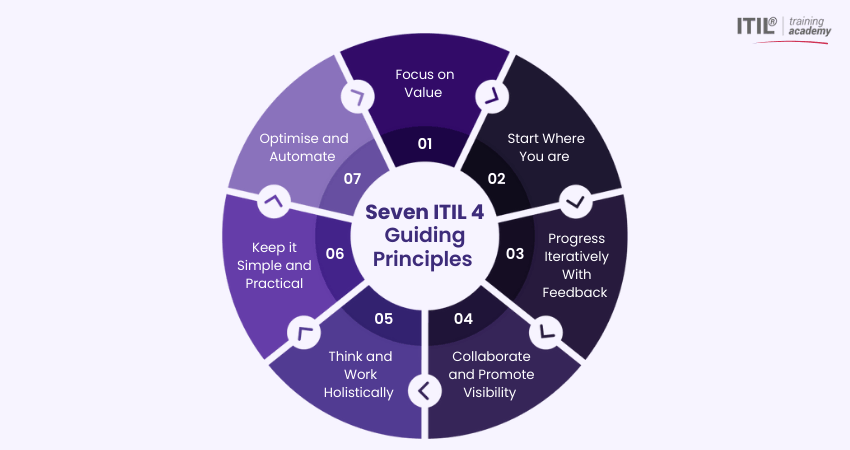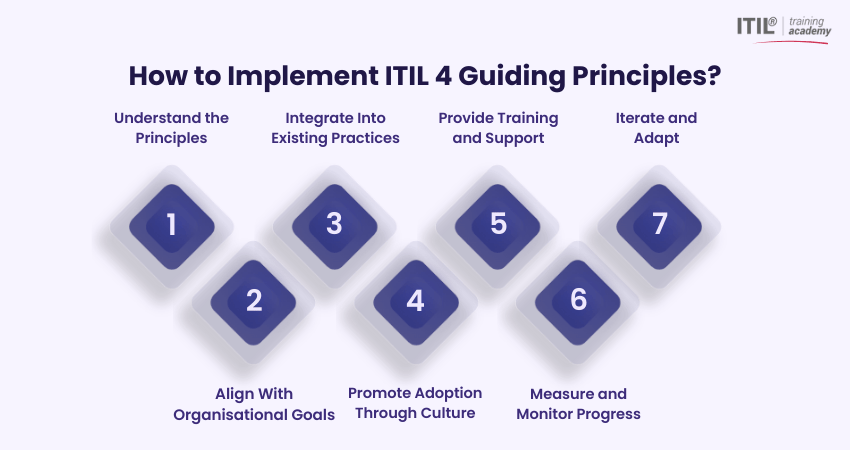
Author-Gary Moore
Last updated-Sep 20, 2025
Tired of firefighting IT issues instead of preventing them? Plenty of teams feel the same way. Many IT departments spend their days reacting to problems, fixing outages, and chasing tickets, while struggling to prove their value to the business. But what if your IT department could move from reactive to proactive? What if every project and service were led by clear, practical principles that improve results and keep users happy?
That’s exactly what the ITIL 4 Guiding Principles are designed to do. These seven simple yet powerful principles focus on what matters most and deliver value. In this blog, you’ll learn how each principle works, why they matter, and how to apply them in real-world IT environments. Let's dive in!
Table of Contents
1) What is ITIL?
2) The 7 ITIL 4 Guiding Principles
3) How to Use the 7 ITIL Guiding Principles?
4) How Can Organisations Put the ITIL 4 Guiding Principles Into Practice?
5) What are the Benefits of Applying the Guiding Principles?
6) Conclusion
What is ITIL?
The Information Technology Infrastructure Library (ITIL) is a globally recognised framework designed to streamline IT Service Management. It provides organisations with a structured set of practices for delivering IT services effectively and efficiently.
The latest version, ITIL 4, is built on a more flexible approach. It integrates practices from frameworks like Agile, DevOps, and Lean to promote collaboration, adaptability, and continuous improvement.
The 7 ITIL 4 Guiding Principles
The ITIL 4 Guiding Principles are a mindset to support decision-making and behaviour. Let’s check into each one:

1) Focus on Value
Value isn’t just about money. It is about delivering meaningful outcomes for customers, users, and the business. Every activity, investment, or initiative within an organisation needs to be focused on providing value. By referring to value, it isn't only about profit. It could mean improved performance, enhanced user experience, or reduced downtime.
This principle of ITIL 4 encourages organisations to understand who uses their services, what matters to them, and how each action contributes to a positive experience.
2) Start Where You are
There’s no need to build everything from scratch. Instead, assess your current state; including processes, resources, capabilities, and tools. Leveraging existing resources saves time, reduces waste, and prevents unnecessary disruptions. For instance, if your incident management process partly works, don’t replace it. Identify what is effective and improve it.
This principle also highlights the importance of observation. You need to spend time in understanding the real situation to enhance your team.
3) Progress Iteratively With Feedback
Trying to complete everything at once can lead to delays, confusion, and subpar outcomes. Instead, break work into small, manageable parts. Deliver them step by step, review results, and use feedback to make continuous adjustments.
It helps you release a working version, get user input, and improve as you go. This avoids costly rework after finishing the whole work and builds trust with users through your progression.
4) Collaborate and Promote Visibility
IT Service Management is a completely team-based work culture. You need to work together with various people within and among other teams. There needs to be collaboration with internal teams, customers, vendors, and any other stakeholders. Strong collaboration brings in various perspectives, encourages innovation, and avoids duplicated efforts.
Visibility goes hand in hand with collaboration. When everyone has access to relevant information, decisions are faster and more accurate.
Deliver services that truly meet stakeholder needs with our ITIL® 4 Specialist: Drive Stakeholder Value (DSV) Training – Register today!
5) Think and Work Holistically
IT systems are complex and interconnected. Where there is a change in one area, it often impacts another. That’s why it is important to understand the broader system before making any decisions. This also means you need to be extra careful to ensure that your efforts align with broader organisational goals.
By thinking holistically, you can predict outcomes better, reduce risk, and ensure that changes support the entire business.
6) Keep it Simple and Practical
There is a misconception that being complex means they are most suitable. But it is not necessary, and complex doesn’t always mean better. Often, the best solutions are the simplest ones. This principle encourages teams to remove all the unnecessary steps, avoid confusion, and focus on what truly matters.
It refers to being practical, logical, and always keeping the user in mind. Simpler processes are easier to follow, train for, and more flexible to change.
7) Optimise and Automate
Before automating any process, you need to optimise it. There’s no use in automating a broken or inefficient workflow. Therefore, start by improving the process manually. Later, you can look for ways to automate repetitive or time-consuming tasks.

Also, be careful of what needs to be automated and what shouldn’t be. The goal is to free up human time for high-value work and reduce the chance of human error.
How to Use the 7 ITIL Guiding Principles?
The seven ITIL Guiding Principles are designed to be used in combination and tailored to the context of a situation. Here’s how to effectively apply them:
1) Look at the Situation: Understand what the problem or opportunity is and identify who is involved or impacted.
2) Pick the Right Principles: You don’t need to use all seven principles every time. You can apply the relevant principle as per your needs.
3) Balance the Principles: Sometimes the principles may seem to clash. In those incidents, you can use a common focus to find the best balance.
4) Make it Part of Daily Work: Tell your team to use these principles in everyday tasks like daily meetings, planning, and reviews.
Overall, these principles act as a compass for the teams to stay focused, improve constantly, and work smarter throughout the service lifecycle.
Drive innovation in delivering digital services at speed with our ITIL® 4 Specialist: High Velocity IT Training – Join soon!
How Can Organisations Effectively Implement the ITIL 4 Guiding Principles?
Now, let’s check how you can implement the seven ITIL 4 Guiding Principles in your business:

Understand the Principles:
Begin by making sure everyone from the leadership team to the frontline teams understands what each principle means and why it matters. A clear understanding helps teams apply these principles correctly in different situations. This shared understanding creates consistency in how services are delivered.
Align With Organisational Goals:
Assess how each principle can support your business objectives. For instance, if your organisation is focused on enhancing customer satisfaction or boosting operational efficiency, directly link these goals to the relevant principles. This ensures that ITSM activities are strategically aligned and contribute to the organisation’s overall success.
Integrate Into Existing Practices:
You don’t need to change your entire ITSM. Look at current policies, workflows, and procedures, and find opportunities to apply the guiding principles within them. For instance, during Change Management or incident resolution, you can include collaboration or value-focused thinking.
Promote Adoption Through Culture:
For long-term success, the guiding principles must be part of your organisational culture. That means encouraging teams to apply them consistently, not just during major initiatives. Leadership plays a key role here. It helps to model the principles in their own actions and recognise teams that do the same.
Provide Training and Support:
Equip your employees with the necessary skills and knowledge to apply the principles effectively. This can include regular training sessions, interactive workshops, and practical job aids or references. Real-life case studies and simulations can also bridge the gap between theory and day-to-day practice, helping teams apply the principles with confidence.
Measure and Monitor Progress:
Use metrics and Key Performance Indicators (KPIs) to track the results of applying the principles for your business. For instance, measure how improvements in collaboration impact response time or service satisfaction. Regular feedback sessions with users and team members will highlight what has been working and where adjustments are needed.
Iterate and Adapt:
Putting the principles into action isn’t something you do just only once. It is a continuous process. You need to keep checking how well they’re used and have to make changes when needed. It can be done based on feedback, business needs, or changes in the industry. This helps your approach stay useful and always improving.
What are the Benefits of Applying the Guiding Principles?
When used well, the ITIL 4 Guiding Principles offer many benefits that help improve IT services and boost overall business success. Here are its benefits:
1) Deliver Real Value: The principles keep teams focused on what matters most. It also delivers outcomes that meet customer and stakeholder needs.
2) Support Value Co-creation: By encouraging collaboration between IT, business teams, and users, they help everyone work together to achieve shared goals.
3) Boost Efficiency and Reduce Waste: Simplifying processes and using automation at the right place saves time, cuts costs, and improves productivity.
4) Strengthen Collaboration: They promote transparency and teamwork across teams, leading to faster decisions and better problem-solving.
5) Align IT With Business Goals: The principles ensure IT services support strategic goals. This makes IT a stronger partner in business success.
6) Drive Continuous Improvement: They encourage teams to learn from feedback, adapt quickly, and improve services as needs grow.
7) Enhance Customer Satisfaction: A strong focus on value and user needs results in more reliable, user-friendly services and happier customers.
8) Offer Flexibility and Scalability: The principles provide a flexible approach that can be adjusted to fit any situation and grow along with the organisation.
Conclusion
The ITIL 4 Guiding Principles provide a practical and flexible mindset that helps organisations face the complexities of modern IT Service Management. Whether you're delivering day-to-day support or driving digital transformation, they can help you with better decisions, stronger collaboration, and a sharper focus on value. In a fast-changing world, IT teams need a strong direction, and these ITIL Principles deliver just that.
Confidently lead high-performing IT teams with our ITIL 4 Managing Professional Training – Explore now!
Most Recent
Date - Sep 20, 2025
Date - Sep 20, 2025
Date - Sep 20, 2025





 Back to
Topics
Back to
Topics

























